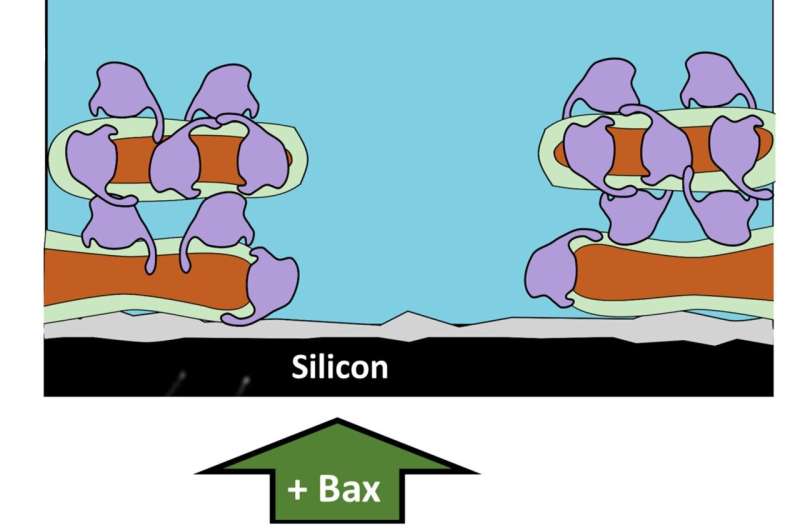
Researchers have for the first time characterized a unique molecular mechanism of the early stages of programmed cell death or apoptosis, a process which plays a crucial role in prevention of cancer.
The study, which is published June 2, 2023 in Science Advances, was led by Dr. Luke Clifton at the STFC ISIS Neutron and Muon Source (ISIS) in Oxfordshire, alongside co-lead Professor Gerhard Gröbner at the University of Umeå and partners at the European Spallation Source in Sweden. It is the most recent in a series of research collaborations by this team, investigating the cellular proteins responsible for apoptosis.
Apoptosis is essential for human life, and its disruption can cause cancerous cells to grow and not respond to cancer treatment. In healthy cells, it is regulated by two proteins with opposing roles known as Bax and Bcl-2.
The soluble Bax protein is responsible for the clearance of old or diseased cells, and when activated, it perforates the cell mitochondrial membrane to form pores that trigger programmed cell death. This can be offset by Bcl-2, which is embedded within the mitochondrial membrane, where it acts to prevent untimely cell death by capturing and sequestering Bax proteins.
In cancerous cells, the survival protein Bcl-2 is overproduced, leading to uninhibited cell proliferation. While this process has long since been understood to be important to the development of cancer however, the precise role of Bax and the mitochondrial membrane in apoptosis has been unclear until now.
Dr. Luke Clifton, STFC ISIS Neutron and Muon Source scientist and co-lead author, explains, “This work has both advanced our knowledge of fundamental mammalian cell processes and opened exciting possibilities for future research. Understanding what things look like when cells work properly is an important step to understanding what goes wrong in cancerous cells and so this could open doors to possible treatments.”
The team used a technique known as neutron reflectometry (conducted using the advanced ISIS Surf and Offspec instruments) which enabled them to study how Bax interacts with lipids in the mitochondrial membrane. This built on their previous studies of membrane-bound Bcl‑2.

Using neutron reflectometry on SURF and OFFSPEC, they were able to study in real time the way that the protein interacts with lipids present in the mitochondrial membrane, during the initial stages of apoptosis. By employing deuterium-isotope labeling, they determined for the first time that when Bax creates pores, it extracts lipids from the mitochondrial membrane to form lipid-Bax clusters on the mitochondrial surface.
By using time-resolved neutron reflectometry in combination with surface infrared spectroscopy in the ISIS biolab, they were able to see that this pore creation occurred in two stages. Initial fast adsorption of Bax onto the mitochondrial membrane surface was followed by a slower formation of membrane-destroying pores and Bax-lipid clusters, which occurred simultaneously. This slower perforation process occurred on timescales of several hours, comparable to cell death in vivo.
This is the first time that scientists have found direct evidence of the involvement of mitochondrial lipids during membrane perturbing in cell death initiated by Bax proteins.
Dr. Luke Clifton continues, “As far as we can tell, this mechanism by which Bax initiates cell death is previously unseen. Once we know more about the interplay between Bax and Bcl-2 and how it relates to this mechanism, we’ll have a more complete picture of a process that is fundamental to human life. This work really shows the capabilities of neutron reflectometry in structural studies on membrane biochemistry.”
The finding builds on previous studies by the team on the molecular mechanism of membrane-bound Bcl-2 to inform a more complete understanding of the early stages of apoptosis.
Professor Gerhard Gröbner, University of Umeå scientist and and co-lead author says, “The unique findings here will not only have a significant impact in the field of apoptosis research but will also open gateways for exploring Bax and its relatives as interesting targets in cancer therapy such as by tuning up their cell-killing potential.”
Future research is planned at ISIS to further elucidate the molecular mechanism of apoptosis and in particular, to characterize the interplay between Bax and Bcl-2. It is hoped that this will yield insights which will open new avenues of research to continue to develop our understanding of the cellular processes necessary for human life.
More information:
Luke Clifton et al, Creation of distinctive Bax-lipid complexes at mitochondrial membrane surfaces drives pore formation to initiate apoptosis, Science Advances (2023). DOI: 10.1126/sciadv.adg7940. www.science.org/doi/10.1126/sciadv.adg7940
Journal information:
Science Advances
Source: Read Full Article
